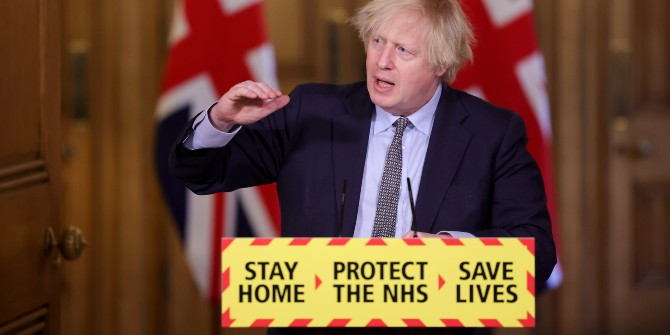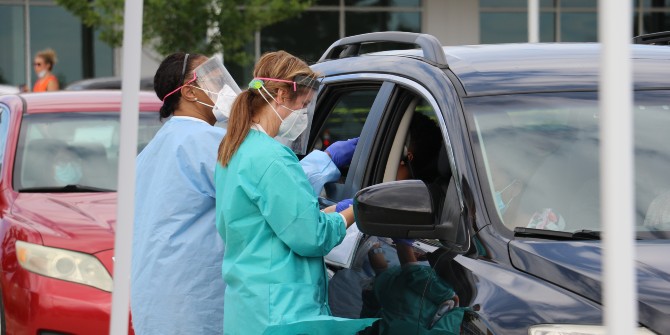The burden of COVID restrictions fell unequally across the population, and some of those most affected were not represented at the policy table. Michael Daly (Maynooth University) and Liam Delaney (LSE) suggest how acknowledging the importance of wellbeing could lead to a less myopic response.
Thanks to several large-scale, longitudinal studies, we are able to see how people’s mental health and wellbeing fluctuated during the pandemic. During the initial stages (March/April 2020), there was an increase in mental health symptoms, with depressive symptoms most affected. After this point (May-July 2020), the severity of mental health symptoms declined, potentially as a result of the easing of restrictions and adaptation to the stressors associated with the pandemic — such as continuous media coverage, fear of infection, financial uncertainty).
In the UK, this pattern was also evident. Data collected as part of the UK Household Longitudinal Study showed that an increase in mental health symptoms occurred between April and June 2020. Similarly, estimates from the UK Annual Population Survey suggested that life satisfaction declined and anxiety worsened throughout this period. The declines in mental health and wellbeing were generally most marked for young people and women, perhaps reflecting the major social disruption experienced by both groups and the disproportionate way in which family and caregiving responsibilities fell upon women.
During the summer and autumn of 2020 wellbeing improved as restrictions were loosened in the UK. However, evidence suggests that declines in mental health and wellbeing began once again after the reintroduction of lockdown measures during the pandemic’s second wave, in the winter of 2020-21. At this point, parents of school-aged children were most likely to experience elevated psychological distress, most probably due to the disruptive character of homeschooling coupled with existing childcare and work responsibilities.
As such, there is at least initial evidence that population wellbeing was related to the scale of the pandemic and to the associated anti-contagion measures in the UK – suffering as cases and deaths rose and restrictions tightened, and reverting slowly to baseline as transmission levels declined and restrictions loosened. However, understanding the mechanisms linking the pandemic and social lockdown measures to population wellbeing has proven difficult because changes in infection and mortality rates and restrictions tend to occur in tandem.
One approach that has proven somewhat informative is the assessment of daily experience through time-use diaries and experience sampling methods. For example, Lades et al. conducted a day reconstruction study to examine time-use and positive and negative affect during the first phase of COVID restrictions in Ireland in April 2020. This study showed that homeschooling children, social media use, and staying informed about COVID during the pandemic were associated with adverse wellbeing effects, whereas spending time outdoors and in nature predicted wellbeing benefits. Similarly, a study of the everyday experiences of Australian adults during the pandemic showed that greater screen time was associated with reduced wellbeing, whereas time spent outdoors was associated with raised emotional wellbeing.
At the population level, the general effects of living through the pandemic may dissipate once vaccination is widespread and immediate stressors like continuous COVID-related media coverage and spending time homeschooling or in social isolation are removed. However, harms to wellbeing may persist for specific groups, such as immunocompromised people, those with long COVID, healthcare staff who have witnessed mortality among patients and colleagues, those at risk of domestic abuse, and children whose specialised educational needs have been neglected. These groups may represent part of the coronavirus’ negative longer-term legacy and planning to address the needs of the groups most impacted by the pandemic has begun, as evidenced by the COVID-19 Mental Health and Wellbeing Recovery Action Plan.
It is important to reflect on the potential for elements of young people’s wellbeing to be trivialised
As the action plan acknowledges, the longer-term economic repercussions of the pandemic require consideration. For instance, those who go on to experience unemployment and underemployment following the pandemic may suffer financial and well-being ‘scarring’ as a result of financial insecurity and weak attachment to the labour force following the pandemic. Because longer-term employment displacement has deeper scarring effects than short-term displacement, policies that prioritise macroeconomic recovery and a return to work may attenuate the scale of these effects. Furthermore, it is likely that younger people can recover from short-run impacts on friendships and social engagement. But far more information is needed on what will happen to longer-run wellbeing in the case that restrictions become an embedded part of response to emerging variants and new waves of the pandemic.
The economic and well-being impact of COVID has been disproportionately borne by younger people, who have experienced significant labour market displacement and disruption to social activities. However, they have been poorly represented in governmental decision-making, with their views and experiences likely undercounted and underweighted.
It is important to reflect on the potential for elements of young people’s wellbeing to be trivialised. For example, the need to develop social relationships in early adulthood and to find social and sexual partners and to form life-long relationships is widely recognised as a key aspect of early adulthood. Framing social activity as non-essential compared to the wider goal of reducing infection risk and preserving life diminishes, and even potentially invalidates, this important aspect of human development and experience. Many other aspects of human social engagement and support were neglected in this way throughout the period.
In a recent paper, we proposed a commission to evaluate the potential population wellbeing impacts of major policy projects, including pandemic responses. Such a commission would help resolve such limitations within government by ensuring that its decision-making is informed by a wide range of disciplinary expertise and by the life experiences and evaluations of citizens from a range of backgrounds.
The integration of behavioural and social scientists into the COVID policy response has been repeatedly and broadly discussed, and to some degree, implemented by government. In the UK, the role of the Scientific Pandemic Insights Group on Behaviours (SPI-B) was to provide “behavioural science advice aimed at anticipating and helping people adhere to interventions that are recommended by medical or epidemiological experts.” While SPI-B contained members that had written on wellbeing-related topics, such as psychosocial resilience, the primary function of this group was limited to supporting the monitoring of and adherence to behaviours, such as social distancing, that sought to control the pandemic. Their remit did not allow for a holistic assessment of wellbeing impacts of policies. For example, it is difficult to imagine how a group like SPI-B could provide a wellbeing impact assessment of investments in mitigating the long-run psychosocial costs of school disruption, or of being exposed to bullying or domestic violence.
A report by the Institute for Government illustrates the decision-making structure of the UK government’s pandemic response during the first six months of the pandemic. While evolving over time, the basic structure of a core scientific advisory team complemented by a behavioural advisory group was maintained. Developing this structure to allow for rapid assessments of medium to long-run psychosocial impacts is something that should be considered as a matter of urgency, both in the context of the ongoing pandemic response and in relation to preparedness for future emergency situations. The Institute of Development Studies has stated that SAGE had “minimal social science representation and is largely confined to narrow behavioural science perspectives” which compared “unfavourably” with other European countries. The Institute also suggested that more expert input was required from “anthropology, geography, sociology, economics, history and related fields.”
It is not that the research community was not providing research on wellbeing effects. The more pressing point is that there is not an obvious channel through which this research could have a meaningful impact on ongoing emergency responses.
Bringing wellbeing measurement into emergency responses could potentially fulfil a number of functions:
- Incorporate a wider diversity of expertise and views: Centring the response around purely medical areas and the default metrics of infections, hospitalisations, and deaths leads to a very homogenous group of advisers and form of input into core policy decisions.
- A framework for evaluating the societal impact of the pandemic: A wellbeing index could capture the impact of a wide range of factors during the pandemic including infection-related worries, the impact of adverse economic circumstances such as unemployment and reduced income, and the effects of social isolation and psychological distress.
- Procedural fairness: The integration of information about people’s wellbeing may be a useful input to policy, independently of whether it changes the precise policy recommendations. People have concerns for procedural fairness and may wish to have their experiences reflected in policy deliberations. Not including such information may suggest that such experiences are not deemed relevant from the view of official policymaking.
- Dampening international conflict and COVID-metric nationalism: The presentation of stark international comparison statistics and case numbers on a nightly basis without context provides conditions for international conflict and status comparison. It also creates incentives for governments to maximise performance on a single index, or even to suppress information.
One potential way to improve the process of responding to emergencies would be to draw from pre-existing multi-dimensional measures of wellbeing. The OECD Better Life Index, for example, contains 11 different dimensions of wellbeing, encompassing income/wealth, housing, job quality, skills, environmental quality, subjective well-being, safety, work-life balance, social connections, and civil engagement.
The psychic cost of not being able to visit a dying loved one may not be measurable, but may be a particularly meaningful loss for people
However, the use of multi-dimensional indices such as the OECD framework potentially also comes at the cost of conceptual clarity and speed of aggregation. In the context of an emergency situation, moving from 11 broadly defined dimensions down to an actionable set of policy actions is not particularly straightforward. Similarly, the frameworks themselves do not provide off-the-shelf procedures for ranking policy actions in a clearly quantifiable way. They should be seen as ways of ensuring that key considerations of societal welfare gain a share of attention in the development of responses and in the formulation of decision-making structures, rather than in and of themselves providing clear-cut solutions.
Another aspect of COVID decision-making that could benefit from a wellbeing approach is the assessment of particular policies at different stages of the pandemic. For instance, decisions to restrict visits to people in nursing homes, mandates for face coverings in educational settings, and restrictions on social visits, all potentially have impacts on wellbeing. Furthermore, such impacts may be subtle and hard to measure in traditional wellbeing formats. The psychic cost of not being able to visit a dying loved one may not be measurable using any standard measure of life satisfaction or episodic wellbeing, but may be a particularly meaningful loss for people.
Many bodies, including the WHO, advise people to limit the amount of time they spend consuming information in the media about COVID. In our own recent study, spending time reading about the virus is one of the most psychologically unpleasant daily activities people regularly undertake. In that case, there is an interesting ethical tradeoff surrounding the potential behavioural adherence effects of regular press briefings and the discussion of the threat it poses and the experiential effect that this has upon the population.

In many frameworks, one explicit goal of risk communication is to help people manage anxiety and set risk in proportion, whereas a policy focused solely on mortality reduction may involve explicitly attempting to get people to focus on COVID risk at the expense of other aspects of their wellbeing. Furthermore, if people become desensitised to regular, alarming broadcasts about mortality then their efficacy as a behavioural change tool will be diminished. It is highly possible that those engaging most with these messages are both already compliant and highly anxious about COVID anyway.
The UK government recently released a report on integrating mental health into pandemic responses. It was very welcome but came one year after Covid was a fully live policy issue. It is urgent to rebuild the discussion of COVID around multi-dimensional measures of wellbeing that situate health and mortality risk among the factors that allow for quality of life across the life cycle. A wellbeing focus can inform the development of structures that advise the government on its pandemic response and its wider emergency response, ensuring that the government’s focus is less myopic. Moving to a wellbeing discourse might better recognise the discrete experiences of different groups of people in a pandemic, and to provide the government with the means to tailor or adjust its response to reflect the different needs and struggles of these groups.
Acknowledgements
We thank Annette Bauer and Paul Dolan for detailed and insightful comments on an earlier draft of this article.
This post represents the views of the authors and not those of the COVID-19 blog, nor LSE. It is an edited version of Daly, M. and Delaney, L., 2021. Incorporating Well-Being and Mental Health Research to Improve Pandemic Response. LSE Public Policy Review, 2(2), p.5.






Thank you both for this thought provoking article. As a behavioural scientist consulting for Pandata.org during this pandemic attempting to provide some small amount of balance to a constant stream of propaganda and nudge I am appreciative of any voice calling for a more holistic lens. We have become consumed, some might say biased (!), by this disease at the detriment of experiences and financial stability but also much more fundamental aspects of self. When personal autonomy and agency is under attack our whole society is vulnerable. I have continued to be concerned about the lack of any clear ethical framework through which SPI-B and others were advising through and their terms of reference that ignore proportionality of outcome to me continues to be exceptionally problematic. I greatly appreciate others in this field raising voices of question and challenge and proposing a better path.